This article has multiple issues. Please help improve it or discuss these issues on the talk page . (Learn how and when to remove these template messages)
|
An online art gallery is an online version of a contemporary art gallery.
This article has multiple issues. Please help improve it or discuss these issues on the talk page . (Learn how and when to remove these template messages)
|
An online art gallery is an online version of a contemporary art gallery.
An online art gallery is a website that display artworks. Usually, the online gallery is run as a business, with the purpose of displaying the artwork being to promote it to potential buyers. Other variations include:
Viewing art online is an improving experience.[ citation needed ] Ideally, art should appear exactly as it would if seen in the real world, but there are factors that limit the extent to which this is possible. Factors include:
The increased adoption of broadband, and improvement in web programming techniques opens up the opportunity for improved display of art online. Whilst no online gallery yet uses light filtering effects, and 3d photography is not yet available, much richer images and improved display techniques provide the viewer with a much richer experience.
The viewer may be offered the option of zooming such that the texture or pigmentation may be examined. Also in some cases the size of the work can be better appreciated by showing it alongside an image of a person of average height.
Another advantage of Online Galleries is that the art buying public is broadening but people are still somewhat intimidated by most commercial Art Galleries. They think they know nothing about art and I believe that in some cases this disadvantages the sales of some artists. If the potential buyer has access to a wide range of art that they can view in the comfort and safety of their own home they will tend to look a bit deeper and get to know what and who they like.
Online galleries often form part of a wider online operation, with other popular facilities including:

An art museum or art gallery is a building or space for the display of art, usually from the museum's own collection. It might be in public or private ownership, be accessible to all, or have restrictions in place. Although primarily concerned with visual art, art museums are often used as a venue for other cultural exchanges and artistic activities, such as lectures, jewelry, performance arts, music concerts, or poetry readings. Art museums also frequently host themed temporary exhibitions, which often include items on loan from other collections.

Australian art is any art made in or about Australia, or by Australians overseas, from prehistoric times to the present. This includes Aboriginal, Colonial, Landscape, Atelier, early-twentieth-century painters, print makers, photographers, and sculptors influenced by European modernism, Contemporary art. The visual arts have a long history in Australia, with evidence of Aboriginal art dating back at least 30,000 years. Australia has produced many notable artists of both Western and Indigenous Australian schools, including the late-19th-century Heidelberg School plein air painters, the Antipodeans, the Central Australian Hermannsburg School watercolourists, the Western Desert Art Movement and coeval examples of well-known High modernism and Postmodern art.
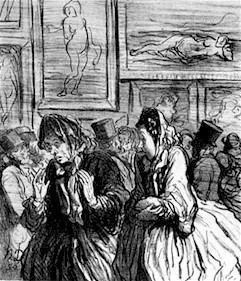
An art exhibition is traditionally the space in which art objects meet an audience. The exhibit is universally understood to be for some temporary period unless, as is occasionally true, it is stated to be a "permanent exhibition". In American English, they may be called "exhibit", "exposition" or "show". In UK English, they are always called "exhibitions" or "shows", and an individual item in the show is an "exhibit".
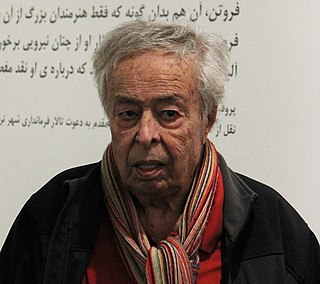
Mohsen Vaziri Moghaddam, was an Iranian-born painter, sculptor, and a professor of art. He was most notable for his style of abstract expressionism, and was once referred to as the "pioneer of modern Iranian abstraction."

An artist-run space or artist-run centre (Canada) is a gallery or other facility operated or directed by artists, frequently circumventing the structures of public art centers, museums, or commercial galleries and allowing for a more experimental program. An artist-run initiative (ARI) is any project run by artists, including sound or visual artists, to present their and others' projects. They might approximate a traditional art gallery space in appearance or function, or they may take a markedly different approach, limited only by the artist's understanding of the term. "Artist-run initiatives" is an umbrella name for many types of artist-generated activity.

An art dealer is a person or company that buys and sells works of art, or acts as the intermediary between the buyers and sellers of art.
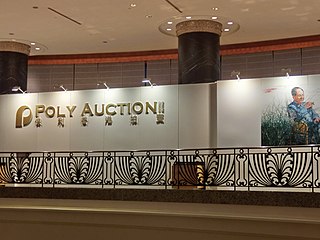
Zeng Fanzhi is a contemporary Chinese artist based in Beijing. Zeng's works have been praised as possessing an emotional directness, an intuitive psychological sense, and a carefully calibrated expressionistic technique.
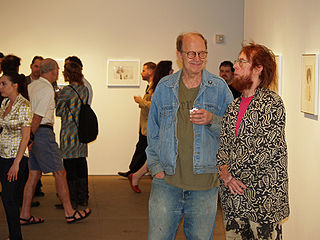
A contemporary art gallery is normally a commercial art gallery operated by an art dealer which specializes in displaying for sale contemporary art, usually new works of art by living artists. This approach has been called the "Castelli Method" after Leo Castelli, whose success was attributed to his active involvement in discovering and promoting emerging artists beginning in the late 1950s with Jasper Johns and Robert Rauschenberg.

For the Love of God is a sculpture by artist Damien Hirst produced in 2007. It consists of a platinum cast of an 18th-century human skull encrusted with 8,601 flawless diamonds, including a pear-shaped pink diamond located in the forehead that is known as the Skull Star Diamond. The skull's teeth are original, and were purchased by Hirst in London. The artwork is a memento mori, or reminder of the mortality of the viewer.

The Rochester Contemporary Art Center is a non-profit art center located in Rochester, New York's East End District. The art center is a venue for the exchange of ideas and a not-for-profit 501(c)(3) that was founded in 1977. As a center for contemporary art, it provides encounters for audiences and opportunities for artists. The center exhibits and supports contemporary art of all forms and is well known for its annual 6x6 exhibition. The art center is also known for its popular Makers & Mentors Exhibitions, which combines notable educators with their current and former students. The State of the City exhibitions focus on new urbanism and feature artists from across the region. The organization hosts numerous other curated group exhibitions, collaborations with arts organizations of all kinds, and community-based projects.
Rhizome is an American not-for-profit arts organization that supports and provides a platform for new media art.
Yin Zhaohui is an artist based in Beijing.

The Los Angeles Municipal Art Gallery is located in the Barnsdall Art Park in Los Angeles, California. It focuses on the arts and artists of Southern California. The gallery was first established in 1954.
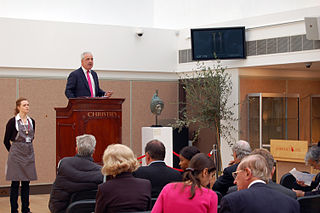
Art valuation, an art-specific subset of financial valuation, is the process of estimating the market value of works of art. As such, it is more of a financial rather than an aesthetic concern, however, subjective views of cultural value play a part as well. Art valuation involves comparing data from multiple sources such as art auction houses, private and corporate collectors, curators, art dealer activities, gallerists, experienced consultants, and specialized market analysts to arrive at a value. Art valuation is accomplished not only for collection, investment, divestment, and financing purposes, but as part of estate valuations, for charitable contributions, for tax planning, insurance, and loan collateral purposes. This article deals with the valuation of works of fine art, especially contemporary art, at the top end of the international market, but similar principles apply to the valuation of less expensive art and antiques.

The National Museum of Fine Arts is a national art museum in Tirana, Albania, under the supervision of the Ministry of Culture. It features the work of well-known Albanian artist, such as Sadik Kaceli.
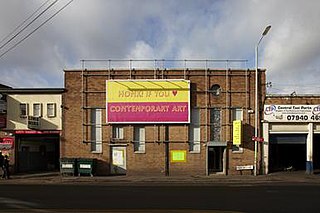
Eastside Projects is an artist-run space in the Digbeth area of Birmingham, England. It is a free public space that is imagined and organised by artists, and includes galleries and studios. It commissions and presents experimental contemporary art exhibitions and proposes ways in which art may be useful to society. It is organised by Simon Bloor, Tom Bloor, Céline Condorelli, Ruth Claxton, James Langdon, and Gavin Wade, who first conceived and now runs the space. The gallery has a programme for high-profile exhibitions and events.

#class was a month-long series of events at Winkleman Gallery in New York that took place between February 20 to March 20, 2010 organized by artists William Powhida and Jennifer Dalton. The exhibition combined social media and networking with a physical gallery space.

An exhibition, in the most general sense, is an organized presentation and display of a selection of items. In practice, exhibitions usually occur within a cultural or educational setting such as a museum, art gallery, park, library, exhibition hall, or World's fairs. Exhibitions can include many things such as art in both major museums and smaller galleries, interpretive exhibitions, natural history museums and history museums, and also varieties such as more commercially focused exhibitions and trade fairs. They can also foster community engagement, dialogue, and education, providing visitors with opportunities to explore diverse perspectives, historical contexts, and contemporary issues. Additionally, exhibitions frequently contribute to the promotion of artists, innovators, and industries, acting as a conduit for the exchange of ideas and the celebration of human creativity and achievement.

Since their invention and subsequent proliferation in the mid-20th century, ballpoint pens have proven to be a versatile art medium for professional artists as well as amateur doodlers. Ballpoint pen artwork created over the years have been favorably compared to art created using traditional art mediums. Low cost, availability, and portability are cited by practitioners as qualities which make this common writing tool a convenient, alternative art supply.

An art gallery is a room or a building in which visual art is displayed. In Western cultures from the mid-15th century, a gallery was any long, narrow covered passage along a wall, first used in the sense of a place for art in the 1590s. The long gallery in Elizabethan and Jacobean houses served many purposes including the display of art. Historically, art is displayed as evidence of status and wealth, and for religious art as objects of ritual or the depiction of narratives. The first galleries were in the palaces of the aristocracy, or in churches. As art collections grew, buildings became dedicated to art, becoming the first art museums.